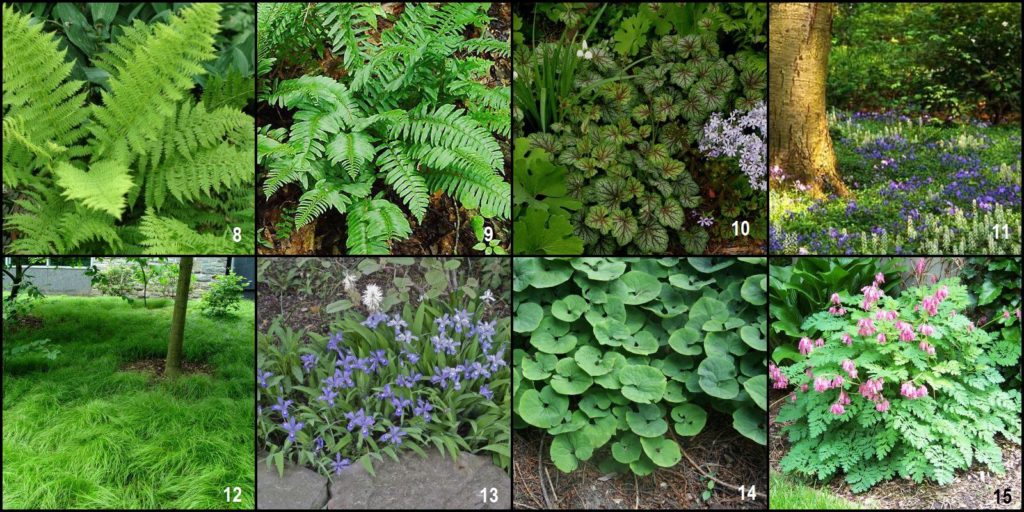By now all of you GreenWeaver fans should have your native shade tree planted on the southwest corner of your house for energy efficiency, wildlife habitat, and comfort just in time for the summer heat!
The next question is: What do you plant under it? Or in any shady location on your property? We all know that turf grass does not grow well in the shade, so the answer must be… hostas? Well not if you have deer, and not if you want to provide rich habitat.
The best answer takes a little thought, but with some knowledge and planning, you will be able to enjoy the shady parts of your gardens, especially in the summertime.
Since most of the East Coast was covered in forest prior to colonization, most of the plants native to this area grow quite well in shade, including understory trees, shrubs, and perennials.
Understory Trees
From Flowering Dogwood (Cornus florida) (1) to Eastern Redbud (Cercis canadensis) (2) to the less familiar Carolina Silverbell (Halesia carolina) (3) and Hophornbeam (Ostrya virginiana) (4), there are many wonderful understory trees from which to choose. All should do reasonably well in a partially shady location, since understory means under the canopy of larger shade trees. Adding understory trees below taller canopy trees can transform a property into a woodland garden, adding another layer of structure and interest.
Shady Shrubs
Below, and mixed throughout the shady areas of your property, consider shrubs such as Virginia Sweetspire (Itea virginica) (5), Oakleaf Hydrangea (Hydrangea quercifolia) (6), and Arrowwood Viburnum (Viburnum dentatum) (7). Once again, many of these shrubs are adapted to shade, and with the right soil conditions they should do quite well. Be aware that in deep shade most plants may become a bit leggy, and may not bloom as profusely as in a sunnier spot.
Woodland Groundcovers
On the ground layer, texture is the name of the game. Mixing large leaves with finer textures adds interest in areas where you may not get profuse blooms or color. Ferns, such as Lady Fern (Athyrium filix-femina) (8) and Christmas Fern (Polystichum arostichoides) (9), can play off the larger leaves of Coral Bells (Heuchera sp.) (10). Use Creeping phlox (Phlox stolonifera) and Foamflower (Tiarella cordifolia) as a classic woodland combination (11). And plants such as Pennsylvania Sedge (Carex pennsylvanica) (12), Dwarf Crested Iris (Iris cristata) (13) , Wild ginger (Asarum canadense) (14), and Wild Bleeding Heart (Dicentra eximia) (15) provide many different textures. The beautiful flowers of many of these plants almost become secondary to the interest that the textures provide. Just remember that it is important to take soil conditions into consideration, especially on the ground layer, and choose plants that fit the existing conditions instead of choosing plants and then trying to change the conditions to suit their needs.
Maintenance in these shady areas is generally not difficult, depending on your expectations. As always, we recommend planting enough plants to out-compete the weeds. A bare space in the garden will eventually be filled with something, so make it something that you want. Then, all that remains to be done is to remove or manage the undesirables, such as Garlic Mustard and Japanese Stiltgrass. Leaves can be left where they fall to decompose on their own. Mowing is never necessary.
The subtle beauty of a shade garden is guaranteed to be peaceful spot, especially in the summer. So look into these wonderful woodland gems and you may find yourself planting more shade trees in order to turn your entire property into a shady summer retreat.




